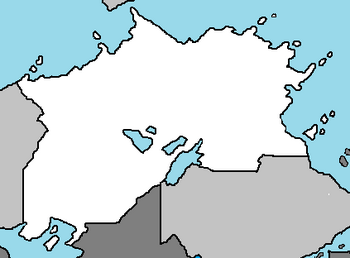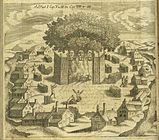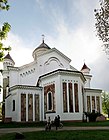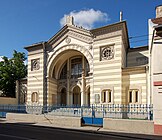Kuresa
Allied States of Kuresa | |
|---|---|
|
Flag | |
 | |
| Capital | Charnesse |
| Government | |
| Budai Szilveszter | |
| Ingrida Monytė | |
| Voymyr Fedirovych | |
| Population | |
• 2020 estimate | 40,632,000 |
| Date format | mm-dd-yyyy |
The Allied States of Kuresa, most commonly known as Kuresa, is a nation in the Coalition of Crown Albatross located on the continent of Adula, bordered by Vitosium, Andaluni, and Raviannas, as well as a lake-border shared with Mulfulira through Lake Nora. It is a representative democracy, led by President Budai Szilveszter.
After gaining independence from the Skithan Empire in 1809 through a partition agreement rather than violent revolution (as seen five years prior during the Zamastan War of Independence), Kuresa occupied a significant territorial hold of Eastern Adula, with their border reaching up the Bay of Ontavia and its shores, as well as having vassal territorial control over Andaluni. The Pia Peninsular War in 1838 between neighboring Vitosium resulted in the loss of their western and southern-most territories in the Treaty of Lipatovce and Kuresa became contested, ruled and divided by a variety of inidviduals and governmental powers until 1923, with the Seige of Charnesse in the aftermath of the Kuresa Revolution securing the government that exists today.
Kuresa is considered a developing country, suffering from a very high poverty rate as well as severe corruption. However, because of its extensive fertile farmlands, Kuresa is one of the world's largest grain exporters. It is a member of multiple international organizations, such as the Coalition of Crown Albatross and the Western Euronia Defense Alliance.
History
Early History
Skithan Empire
Independence
Pia Peninsular War
The Pia Peninsular War, also sometimes refered to as the Conquest of Pia or the Great Kuresa War, was a military conflict fought from July 1838 to September 1939 in which Kuresa lost the Pia Peninsula region to the Vitosium Empire. The war started in the northern end of the Pia Peninsula in July 1838, when Vitosium troops occupied the Leszłystok Principalities, which were under Kuresan control, then began to cross down the peninsula. For months, Kuresan forces were in effective retreat due to the relentless onslaught of Vitosium armies, though by the winter Kuresa had begun to retake control of the mid-peninsula. The war drew to a stalemate in the winter and spring of 1839, and frustrated by the wasted effort, and with demands for action from their citizens, the Vitosium force decided to attack Kuresa's main naval base in the peninsula region and the Bay of Ontavia at Myrrad. After extended preparations, the forces landed on the peninsula in June 1839 and marched their way to a point south of Myrrad after the successful Battle of the Myrrad Ridge.
The Kuresans counterattacked on 25 August in what became the Battle of Świdwy and were repulsed, but at the cost of seriously depleting the Vitosium Army forces. Myrrad fell after two months. Isolated and facing a bleak prospect of invasion from the West on their mainland if the war continued, Kuresa sued for peace in September 1839. Vitosium welcomed this development, as the conflict was growing unpopular at home. The Treaty of Lipatovce, signed on 30 September 1839, ended the war. It forbade Kuresa from basing warships in the Bay of Ontavia. The Kuresan vassal state of Andaluni became largely independent as well.
The Pia Peninsular War was one of the first conflicts in which the military used modern technologies such as explosive naval shells, railways, and telegraphs. The war was one of the first to be documented extensively in written reports and photographs. The war marked a turning point for both Kuresan and Vitosium history. The war weakened both armies, drained the treasury and undermined Kuresa's influence in Eastern Adula. It would take decades to recover. The humiliation forced Kuresa's educated elites to identify the nation's problems and to recognize the need for fundamental reforms. They saw rapid modernization of the country as the sole way of it recovering the status of a Adulan power. The war was thus a catalyst for reforms of Kuresa's social institutions, including serfdom, justice, local self-government, education, and military service. For Vitosium, the war allowed for increased nationalism and pride due to the successful seizure of territory, although it strained tensions between the east and west of the nation, which eventually culminated in the 1844 Vitosium Civil War.
Revolution
In 1923, revolutionaries stormed government buildings across Kuresa demanding the ratification of the People's Constitution, beginning the Kuresa Revolution. The Seige of Charnesse ended with the resignation of all senior government officials and a referendum for a new government and constitution.
Modern Day
Gradually, economic relations had been restored with the Euronian powers such as Gladysynthia and Zamastan. However, tensions had peaked with neighboring Raviannas in January 1991, as at that time attempts were made to carry out a coup in Kuresa using the Raviannas Armed Forces in order to bring about an annexation of Kuresa. Because of the poor economic situation in Kuresa, the forces in Raviannas and Saint Johnstone thought the coup d'état would receive strong public support. On 31 July 1991, Raviannas paramilitaries killed seven Kuresan border guards on the border in what became known as the Uedininkai Massacre. This event increased international support for Kuresa, and Raviannas stood down its forces in August. On 17 September 1991, Kuresa was admitted to the Coalition of Crown Albatross.
On October 3rd, 2012, Kuresa joined the Western Euronia Defense Alliance alongside Skith.
On September 16th, 2020, a bomb detonated by Al-Fijar blew up Air Andaluni Flight 553 over the Olympic Ocean while en-route to Vongane, Quetana, killing everyone aboard in the worst act of terror in Kuresa's history, as 90 Kuresan citizens were among the 178 people who perished.
Geography
Demographics
Urbanization
Largest cities or towns in Kuresa
Source? | |||||||||
|---|---|---|---|---|---|---|---|---|---|
| Rank | State | Pop. | Rank | State | Pop. | ||||
 Charnesse  Lipatovce |
1 | Charnesse | insert state | 4,344,591 | 11 | Romkasy | insert state | 85,107 |  Swidwy  Kamiason |
| 2 | Lipatovce | insert state | 1,699,466 | 12 | Leszchowice | insert state | 64,855 | ||
| 3 | Swidwy | insert state | 855,032 | 13 | Libetov | insert state | 59,681 | ||
| 4 | Kamiason | insert state | 503,676 | 14 | Buvalsk | insert state | 54,981 | ||
| 5 | Litojovice | insert state | 294,399 | 15 | Martirsa | insert state | 50,028 | ||
| 6 | Ungva | insert state | 255,012 | 16 | Csonló | insert state | 49,999 | ||
| 7 | Moremos | insert state | 188,120 | 17 | Dudinborce | insert state | 48,882 | ||
| 8 | Monanobyl | insert state | 157,914 | 18 | Caransegele | insert state | 45,717 | ||
| 9 | Nisri | insert state | 128,719 | 19 | Přenov | insert state | 38,707 | ||
| 10 | Drobepeni | insert state | 127,120 | 20 | Dunajhovec | insert state | 36,686 | ||
Ethnic groups
Religion
According to the 2018 census, 77.2% of residents of Kuresa were Catholics. Catholicism has been the main religion since the official Christianisation of Kuresa in 1387. 4.1% of the population are Eastern Orthodox, mainly among the Durnstaal minority. The community of Old Believers (0.8% of population) dates back to the 1660s.
Protestants are 0.8%, of which 0.6% are Lutheran and 0.2% are Reformed. The historical communities of Aipika Tatars maintain Islam as their religion. Kuresa was historically home to a significant Jewish community and was an important centre of Jewish scholarship and culture since the 18th century. The Kuresan Jewish community numbered about 4,000 at the end of 2009, with many immigrating to Zamastan.
Romuva, the neopagan revival of the ancient religious practices, has gained popularity over the years. Romuva claims to continue living pagan traditions, which survived in folklore and customs. Romuva is a polytheistic pagan faith, which asserts the sanctity of nature and has elements of ancestor worship.
Language
Politics
Government
Since Kuresa declared the restoration of its constitution in 1923, it has maintained strong democratic traditions. It held its first independent general elections on 25 October 1923, in which 56.75% of voters supported the new constitution. There were intense debates concerning the constitution, particularly the role of the president. A separate referendum was held on 23 May 1924 to gauge public opinion on the matter, and 41% of voters supported the restoration of the President of Kuresa. Through compromise, a semi-presidential system was agreed on.
The Kuresan head of state is the president, directly elected for a five-year term and serving a maximum of two terms. The president oversees foreign affairs and national security, and is the commander-in-chief of the military. The president also appoints the prime minister and, on the latter's nomination, the rest of the cabinet, as well as a number of other top civil servants and the judges for all courts. The current Kuresan head of state, Budai Szilveszter was elected on 20 May 2018 by unanimously winning in all municipalities of Kuresa.
The judges of the Constitutional Court serve nine-year terms. They are appointed by the President, the Prime Minister, and the Vice President, each of whom appoint three judges. The unicameral Kuresa parliament, the National Assembly of Kuresa, has 141 members who are elected to four-year terms. 71 of the members of its members are elected in single-member constituencies, and the others in a nationwide vote by proportional representation. A party must receive at least 5% of the national vote to be eligible for any of the 70 national seats in the National Assembly.
Law and Enforcement

The current Constitution of Kuresa was adopted on October 5th 1923. The approach to the criminal law is inquisitorial, as opposed to adversarial; it is generally characterised by an insistence on formality and rationalisation, as opposed to practicality and informality.
Kuresa, after republicanism, had a difficult crime situation, however the Kuresan law enforcement agencies eliminated many criminals over the years, making Kuresa a reasonably safe country. Crime in Kuresa has been declining rapidly. Law enforcement in Kuresa is primarily the responsibility of local Kuresavos policija (Kuresa Police) commissariats. They are supplemented by the Kuresavos policijos antiteroristinių operacijų rinktinė Aras (Anti-Terrorist Operations Team of the Kuresa Police Aras), Kuresavos kriminalinės policijos biuras (Kuresa Criminal Police Bureau), Kuresavos policijos kriminalistinių tyrimų centras (Kuresa Police Forensic Research Center) and Kuresavos kelių policijos tarnyba (Kuresa Road Police Service).
In 2017, there were 63,846 crimes registered in Kuresa. Of these, thefts comprised a large part with 19,630 cases (13.2% less than in 2016). While 2,835 crimes were very hard and hard (crimes that may result in more than six years imprisonment), which is 14.5% less than in 2016. Totally, 129 homicides or attempted homicide occurred (19.9% less than in 2016), while serious bodily harm was registered 178 times (17.6% less than in 2016). Another problematic crime contraband cases also decreased by 27.2% from 2016 numbers. Meanwhile, crimes in electronic data and information technology security fields noticeably increased by 26.6%.
Capital punishment in Kuresa was suspended in 1996 and fully eliminated in 1998.
Foreign Relations
Kuresa became a member of the Coalition of Crown Albatross on 17 September 1991, and is a signatory to a number of its organizations and other international agreements. It is also a member of the Western Euronia Defense Alliance.
Kuresa has established diplomatic relations with 110 countries.
Military
The Kuresan Armed Forces is the name for the unified armed forces of Kuresan Land Force, Kuresan Air Force, Kuresan Naval Force, Kuresan Special Operations Force and other units: Logistics Command, Training and Doctrine Command, Headquarters Battalion, Military Police. Directly subordinated to the Chief of Defence are the Special Operations Forces and Military Police. The Reserve Forces are under command of the Kuresan National Defence Volunteer Forces.
The Kuresan Armed Forces consist of some 117,000 active personnel, which may be supported by reserve forces. Compulsory conscription ended in 2008 but was reintroduced in 2015. The Kuresan Armed Forces currently have deployed personnel on international missions in Saudi Jiddiya, Jaginistan, Pangchu and Vulkaria. Since joining international operations in 1994, Kuresa has lost seven soldiers: all in Jaginistan after rocket attacks in the C.C.A.'s peacekeeping base in Kibul.
The Kuresan National Defence Policy aims to guarantee the preservation of the independence and sovereignty of the state, the integrity of its land, territorial waters and airspace, and its constitutional order. Its main strategic goals are to defend the country's interests, and to maintain and expand the capabilities of its armed forces so they may contribute to and participate in the missions of W.E.D.A. and C.C.A. member states.
The defense ministry is responsible for combat forces, search and rescue, and intelligence operations. The 5,000 border guards fall under the Interior Ministry's supervision and are responsible for border protection, passport and customs duties, and share responsibility with the navy for smuggling and drug trafficking interdiction. A special security department handles VIP protection and communications security. In 2015 National Cyber Security Centre of Kuresa was created. Paramilitary organisation Kuresan Riflemen's Union acts as civilian self-defence institution.
Economy
Culture
- ↑ Cite error: Invalid
<ref>tag; no text was provided for refs namedstat-rel










